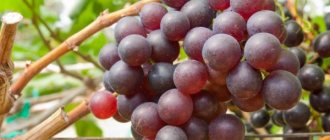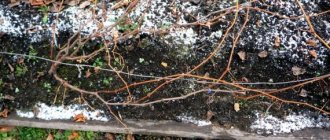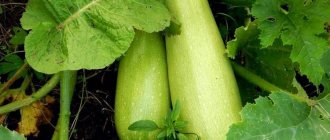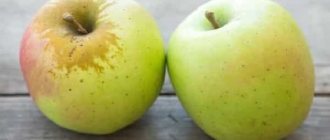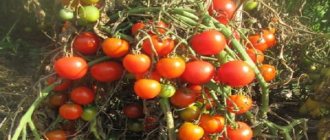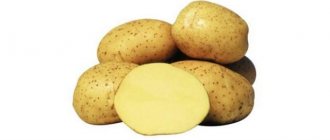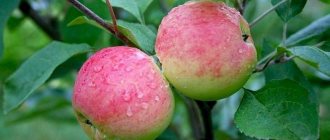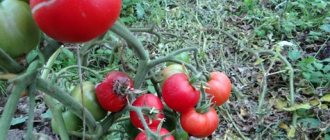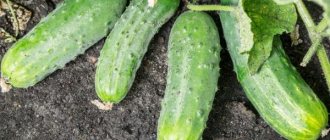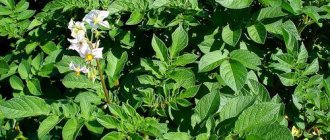Advantages and disadvantages of the type
From the parent shoots the variety took the following advantages:
- high crop ripening rate;
- sweet taste, not overloaded with additional notes;
- consistently high yield ≈ 80 c/ha;
- transportability;
- consumer versatility;
- the berries do not shrink under any weather conditions;
- frost resistance.
The negative aspects of the vineyard include the height of the bushes, which makes harvesting somewhat difficult.
External data
The description of grapes consists of several factors - height of shoots, size of berries, taste, ripening time, transportability of the crop, plant resistance to frost and disease.
Bush and leaves
The bushes of Korinka Russkaya have a non-standard height for grapes; they reach 3 m. The lower tier of the bush consists of shoots 2.1 m long. The vine is light brown in color. The root system is branched and powerful.
This variety can be recognized by its large wrinkled leaves that do not have a deep dissection; the pubescence on them more closely resembles a sparse cobweb.
The color is green, but the veins have a yellowish tint. The bush is strong, strong, spreading and self-fertile; during the flowering period, bisexual flowers bloom on its shoots.
See also
Description and characteristics, pros and cons of the Krasa Severa grape variety and cultivation rulesRead
Yield and taste of berries
The productivity of the Korinka Russian variety is stable and annual. On average, up to 800 kg of sweet berries can be collected from each hectare. The average weight of a bunch is 250 g, its shape is conical, the structure is medium loose, which contributes to better ripening - above 80%. The sugar content of the total mass fraction of juice is 20-22%, acid - 5 g/l.
Tasters found this proportion to be the best. Consumers like this variety of berries for its thin skin, juicy, sweet pulp.
Description of the Russian Korinka grape: characteristics, photos, gardener reviews
Grapes are a revered healthy garden berry, the ripening of which we always look forward to. From the many varieties it is very difficult to choose the one that we like.
The Russian Korinka grape is a wonderful early-ripening variety that attracts with its undeniable advantages - high winter hardiness, abundant harvests, high quality fruits, unpretentiousness in cultivation and care.
Another noteworthy thing about it is that the berries do not contain seeds at all, and the vine is very decorative and will perfectly decorate any summer cottage.
Photo of Russian Korinka grapes.
Description of the variety and its characteristics
Russian Corinka is an amazing grape variety bred in the Tambov region by scientist-breeders L. Shtin and I. Filippenko, who crossed Zarya Severa with Kishmish black. The goal of the scientists was to achieve high winter hardiness of plants. The result was a frost-resistant species that could withstand temperatures down to -28 degrees.
Description of the vine
The variety's bushes, powerful and vigorous, will be a wonderful decoration for any garden building:
- plants are characterized by a high growth rate. They can reach 3 meters in length;
- the vine has strong shoots of light brown color, fully ripening, capable of holding a large harvest;
- the plant root system is well developed;
- leaves of Russian Corinka - five-lobed, large, slightly dissected, rich green in color;
- small white flowers form panicle inflorescences;
- the vine has flowers of both female and male flowering types, that is, the variety is self-pollinating and does not need pollinating varieties;
- Flowering of plants occurs in May. Flowering period - about 10 days;
- Fruiting of grapes occurs 2-3 years after planting.
Technical characteristics of the variety
Korinka Russian belongs to the table varieties, but the round berries are not large - from 8 to 10 mm in length, the color is yellow, the sides of the berries, caressed by the sun's rays, acquire a pinkish blush.
Immunity to diseases
When grown in the Central Black Earth region, the variety has high immunity to common grape diseases. With proper care, absence of waterlogging of the soil and in other regions, this variety can be protected from all types of diseases by preventive treatments of bushes and soil. When growing Corinka Russkaya in cold areas, the main pathogens of grape diseases die in severe frosts.
Frost resistance
In regions where the drop in air temperature does not exceed 26-28 °C, Korinka Russkaya winters comfortably. In areas with harsher climates, this grape variety is grown as a cover crop.
Forum statistics
208685 Messages in 1636 Topics from 5641 Users. Last user: Cerberus Last message: “Rooting wine cuttings...” ( Today at 06:45:27) Latest messages on the forum.
Now on the forum
33 Guests, 11 Users
Users in the last 15 minutes: Elvira2017, YurSanych, Lyubov S., zsb, Evgeniy 50, Nikolai Mikhailovich, Alexander K, vlad51, GALINA ANOKHINA, Evgeniy 163, Evgen_Ev [Blocked] [Section Moderator] [Forum Moderator]
Maximum online today: 112 . All-time maximum online: 2758 (28 July 2021, 17:22:51)
Users who visited the forum in the last 24 hours
Total: 320
(Visible: 319, Hidden: 1) 1963, Elvira2017, YurSanych, Lyubov S., zsb, Capricorn, Evgeniy 50, Nikolai Mikhailovich, Alexander K, vlad51, GALINA ANOKHINA, Andrey 31, Evgeniy 163, Evgen_Ev, Tatyana Provorova, Skif, Casperzrq, leonidych, Natasha, Victor B, Nikolay Lipunov, sergei, Evgeniy52, 77volt, hanter64, Tatyana B, kosmos, slavalimon, Alexander Vl., Mikhail77, skier, rivaN, y_fed, Kazak, Igor Sergeevich, Victor55, Andrey15, OlgaOs, Ilya 77, DorontsovPeter, Chapai, Buba, Mikhno Alexander, dralexk1, alexsandr, Amber7394, SANYCH, Pioneer, DimaRostov, Dmitry 77, Verona, DED2, MaxL, nicson7, Vasily V., Kenig, Alexander Taganrog, VitalySD, Dmitry-Kozadoev, Realist, Alexey Deminov, Elektronik_t, Galinka, DSW, Alexey Agryzkov, Taker, Kadyrov, bonami, antar, Sergey 1965, Andrey gladilin, SvetlanaBondareva, tolya, Nadezhda Grig, Igor Naumov, Igor F., kvg, Pavel 64, Volgar, Roman Fedorovich, igor222, max2008-01, Iv Iv, Vika, Andrey Lis, Evgeny30, lomakin1969, linalenadavi, gheo55, Sergey Chistokletov, mystic69, Grinya, Cherkessk, Andrey76, DIL, Serzh1978, Haus, , Vladimir-kanevskaya, Iglika, Marina Protasova , Mikhail Alekseevich, Linx, Morgana, Igor K, Tatyana Rogacheva, Polyanina Ekaterina, Yuri _Saransk, Sergey 61, Armagnac, Alexander48, tsv, Verbitsky E.I., Lyudmila, Victoria Aleksandrovna, Vladimir Berdnikov, vladimirM, and.drew, Maximilian , Denisovich, Soshnin Yura, Quiet, Elena Z, Sasha57, Natalia Nikolaevna, Yuri Gaivoronsky, Oleg56, weather forecaster, ElenkaF, Lydia58, Vyacheslav03, Sa-shura, irahelm, Pitko, Volodya R, Volgogradka, Alexander71, Natalia1968, Valentina Ivanovna, freesia , L.A.P., Lyuda5, Alexey V, dayton, marlin64, Tanyusha, Vasily1111, Yuri 14, Vova Kapran, Dmitry Nikolaevich, Oleg Filippov, Valery Rastorguev, Kalevanych, AlexsandrP, LeXa_KoT, Sergey Yuryev, Inna161, cfibr, stenlly2010 , rambo, maxbul, Nadymchanka, Ivan Levin, Eduard., nik2, serzhinio, potap05, nadia, VeraNiK, Sergey Tashchiyan, G.V, Amateur gardener, Alexander-ask-34, Vladimir Kostochkin, Wintel, Vyacheslav Vladimirovich, mers, Izhitsa, Ramiz, Ahmed, gardener, P7N, alexss, Zaur, TITOVA LYUBOV, Sergey Ko, Tatyana Volzh, Grandfather Young, pioneer-2, ketch, Bublichenko Alexander M, Ildar, Sergei Vasilevi4, Oleg Ivanovich delivered, Helga, Marshal, Vasily 53, Den, Alexander150, Yavgen3678, vikbublik, Valerie, Henry, Alexander_89, nick041, Svetlana Streletskaya, Antrikan, neposny, yak, 25nata35, Vladimir Buturlakin, Yagodka, Aprel, Antonk1983, PS-URA, spotlight, Nikolay S., Andrey68, Alexander565, Gennady163, AndSanych, Alexander Gai, Alex65, kdm57, oleg9f, Svetlana Korotina, Dmitry Badaev, Belgorodets, Yura, formula1, Cerberus, 64nikolay64, Yuri Semyonov, Kryn, N.A. Sokolov, TIS, Guram, sem_en, Alexander Smirnov , AlexanderD, Spikina Galina, Anatoly Sivkov, Snezhinets, Alexey Sh., mira567, Mst, viktor_, Vadim, Salex, Yuri P., Bison, thanatos, Alexander Sh, Vardan, cecet71, Coltrane, Alexander 61, Andrey Beribesov, Efimych, boltik, Vladimir-27, Vovka, LOZA, ilja, Unter, Gela, Irinka, NatalyaMed, ichtiandr, Sergey Lomonosov, krasnovlad1, Irene, Pirko Alexander, Khramov, YATATYANA, , Vitaly Kholkin, Mihalych., ni, Vladimir Kovba, Rita, nau_63, Yuri72, Lisav, niy1, Timofey, NelyaS, MikhAf, Alexander Zinoviev, Zayac, SNovichek, Tatyana A., VDV, Dmitry-Ivanovich, Saisan, slaviking, court, Vladimir Shilov, Oleg Swedov, Sergey2017, Masha_sadovod, Burundukx, Lamo , Oleg A., arnyusha, Leonty Yarygin, Vyacheslav-56, lena, Igor 31, Sergey 31, Zhorzhovich, nut lover, Enych, turist, Ewgeniy, Ivan Shmelev, atseton, Liza, yotmast
In what areas can it be grown?
Central Russia, the Baltic states and other regions of temperate continental climate are suitable for growing Korinka Russian grapes in open ground. The only peculiarity is the additional insulation of plants in preparation for the winter period. In the Northwestern region, the harvest will take place at the beginning of September, which is almost a month and a half later than this period in the Krasnodar Territory.
Growing in central Russia has one advantage - berries left on the bushes until fully ripened acquire a honey taste and aroma.
Features of agricultural technology
The vine is reminiscent of bindweed, which needs support in order to strive upward, rather than creep along the ground. It is recommended to plant Korinka Russian grapes on a trellis. This will not only decorate the area, but will also give the sun's rays access to more berries. The quality and weight of the harvest will only improve.
See also
Instructions for using the fungicide "Shavit" for grapes, processing times and analoguesRead
Soil moisture
The soil is moistened 4 times per season:
- before the leaves bloom;
- at the initial stage of flowering;
- during the period of formation and swelling of berries;
- Before the onset of frost, the soil is moistened for the last time.
Attention! 4-5 weeks before harvest, watering of the vineyards stops.
Mulching
The soil is insulated with sawdust, straw, hay, and peat after water-recharging irrigation, which simplifies the wintering of the plant. It is first necessary to remove fallen leaves from the area, in which the pathogen can overwinter, and cover the area adjacent to the bush with a 10-centimeter insulating layer. It will create a greenhouse effect. In dry areas, mulching is also carried out in the summer to prevent moisture evaporation and protect the area from weeds.
Trimming
Planned autumn pruning is to plan for next year's harvest. There should be no more than 10 eyes left on each vine. The bush is able to provide nutrients to 40 buds. In the spring, adjustments are made; only one bunch of grapes is left on each vine.
Top dressing
Organic matter is added to the grape bushes in the fall over a period of 2-3 years. Minerals are added to the soil in the spring before flowering, at the time of ovary formation, at the stage of intensive growth of bunches. To obtain a larger bunch, treatments are carried out with Gibberellin.
Protection from diseases and pests
Prevention, timely removal and burning of affected leaves and shoots, spraying with Bordeaux mixture, removing fallen leaves, mulching and draining the area, applying mineral root and foliar fertilizers is the best protection for the plant from insect pests and fungal infections.
Care
Corinka does not have any special requirements for cultivation. It grows well in the sun, but also feels comfortable in partial shade, and in this case the yield is no worse than growing in a sunny area.
Implementation of watering
Grapes do not favor high humidity, so you should be careful with watering. On average, the vineyard is watered every 14-18 days. During flowering and fruiting, watering can be done less frequently, otherwise excess moisture may negatively affect the integrity of the berry skin. After watering, the soil is loosened, at the same time removing weeds that can be sources of disease.
Trimming
Particular attention should be paid to the formation and pruning of the bush. Corinka is a vigorous, spreading bush. It is preferable to grow it on a vertical trellis in a four-arm culture. The formation of the bush is carried out in the first two years - it is during this time that the main stem will grow fruitful vines. Along with pinching the shoots, it is necessary to unload the bush from excess bunches. It is necessary to leave no more than two bunches on one shoot.
Feeding
During the growing season, the grapes are fed 3 times. Fertilizers are applied for the first time in early spring. To increase green mass, nitrogen-containing compounds are added to the soil at the end of April. This can be ammonium nitrate, urea, or organic matter - diluted mullein, bird droppings, slurry. Before flowering, grapes need a portion of minerals, in particular phosphorus and potassium. This time they feed with superphosphate and potassium chloride. For the third time, the bushes are fed with a complex mineral composition necessary for filling the berries.
Protection from diseases and pests
The variety is quite well protected from mildew and gray rot, but is susceptible to oidium disease. In addition, the sweetness of the berries attracts hornets and wasps, which spoil the fruits and infect them with various types of infections. You can protect grapes from the harmful effects of winged insects using a net - it covers the ripening bunches of grapes. Treating the soil with Storm will help protect bushes from rodents. Or you can scatter poison for insects and mice around the grape bushes.
For infections, preventive spraying with copper or iron sulfate is carried out in early spring and autumn.
Korinka's main enemy is oidium. The fungus affects all parts of the plant, starting with the foliage. At this time, the leaves begin to curl, and some shoots, mostly young ones, stop growing. The leaves on both sides are covered with a white dusty coating, and necrosis appears in some places. Gradually, the disease spreads to flowers and fruits - they are also enveloped in a whitish powdery film. In the following stages, all affected areas darken, dry out and die.
The fight against fungus is carried out in a comprehensive manner: temperature and humidity are adjusted, agrotechnical measures are carried out (weeding, loosening, weed removal), thickened areas are thinned out, and severely damaged branches and inflorescences are removed. At the same time, they begin to regularly spray with fungicides. Sulfur-based preparations (Cabrio Top) are especially toxic to pathogens of fungal infections. If the infection has already begun to spread, then the plants are treated with systemic agents, for example, Skor, Topaz, Rubigan. In the case when oidium has already been observed on plantings in previous years, early spring treatment is carried out with Hom, Horus, Strobi.
